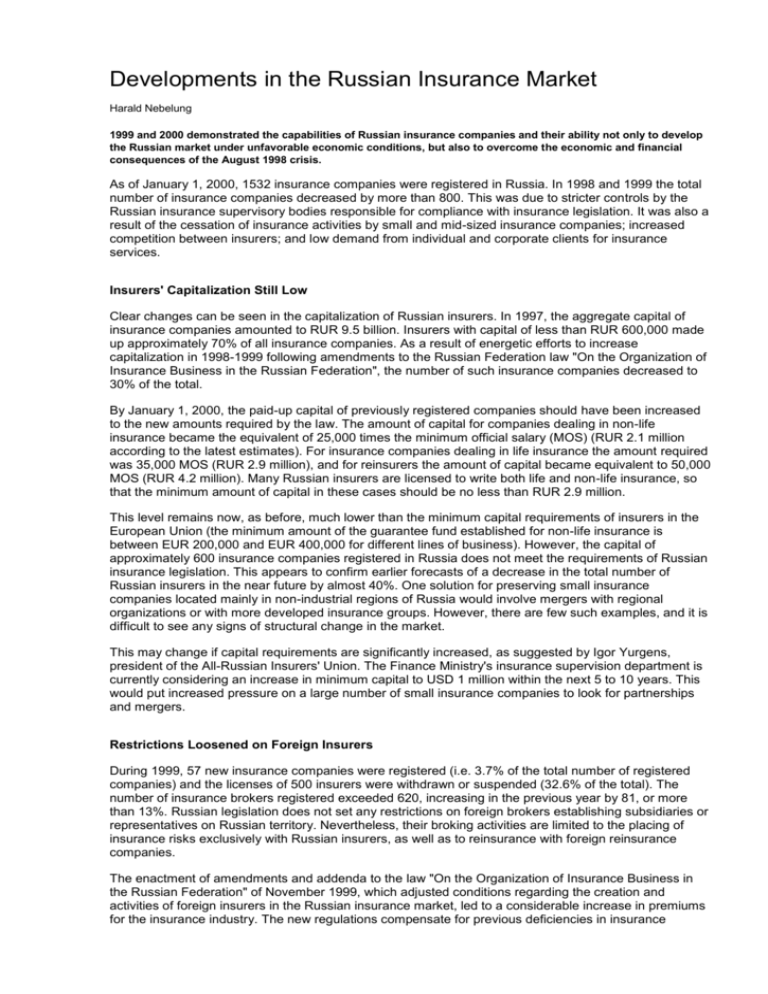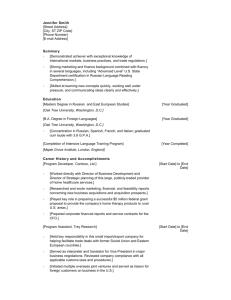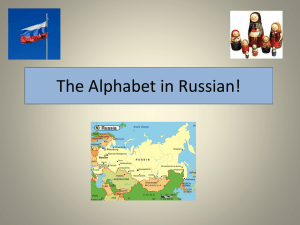Developments in the Russian Insurance Market
advertisement

Developments in the Russian Insurance Market Harald Nebelung 1999 and 2000 demonstrated the capabilities of Russian insurance companies and their ability not only to develop the Russian market under unfavorable economic conditions, but also to overcome the economic and financial consequences of the August 1998 crisis. As of January 1, 2000, 1532 insurance companies were registered in Russia. In 1998 and 1999 the total number of insurance companies decreased by more than 800. This was due to stricter controls by the Russian insurance supervisory bodies responsible for compliance with insurance legislation. It was also a result of the cessation of insurance activities by small and mid-sized insurance companies; increased competition between insurers; and low demand from individual and corporate clients for insurance services. Insurers' Capitalization Still Low Clear changes can be seen in the capitalization of Russian insurers. In 1997, the aggregate capital of insurance companies amounted to RUR 9.5 billion. Insurers with capital of less than RUR 600,000 made up approximately 70% of all insurance companies. As a result of energetic efforts to increase capitalization in 1998-1999 following amendments to the Russian Federation law "On the Organization of Insurance Business in the Russian Federation", the number of such insurance companies decreased to 30% of the total. By January 1, 2000, the paid-up capital of previously registered companies should have been increased to the new amounts required by the law. The amount of capital for companies dealing in non-life insurance became the equivalent of 25,000 times the minimum official salary (MOS) (RUR 2.1 million according to the latest estimates). For insurance companies dealing in life insurance the amount required was 35,000 MOS (RUR 2.9 million), and for reinsurers the amount of capital became equivalent to 50,000 MOS (RUR 4.2 million). Many Russian insurers are licensed to write both life and non-life insurance, so that the minimum amount of capital in these cases should be no less than RUR 2.9 million. This level remains now, as before, much lower than the minimum capital requirements of insurers in the European Union (the minimum amount of the guarantee fund established for non-life insurance is between EUR 200,000 and EUR 400,000 for different lines of business). However, the capital of approximately 600 insurance companies registered in Russia does not meet the requirements of Russian insurance legislation. This appears to confirm earlier forecasts of a decrease in the total number of Russian insurers in the near future by almost 40%. One solution for preserving small insurance companies located mainly in non-industrial regions of Russia would involve mergers with regional organizations or with more developed insurance groups. However, there are few such examples, and it is difficult to see any signs of structural change in the market. This may change if capital requirements are significantly increased, as suggested by Igor Yurgens, president of the All-Russian Insurers' Union. The Finance Ministry's insurance supervision department is currently considering an increase in minimum capital to USD 1 million within the next 5 to 10 years. This would put increased pressure on a large number of small insurance companies to look for partnerships and mergers. Restrictions Loosened on Foreign Insurers During 1999, 57 new insurance companies were registered (i.e. 3.7% of the total number of registered companies) and the licenses of 500 insurers were withdrawn or suspended (32.6% of the total). The number of insurance brokers registered exceeded 620, increasing in the previous year by 81, or more than 13%. Russian legislation does not set any restrictions on foreign brokers establishing subsidiaries or representatives on Russian territory. Nevertheless, their broking activities are limited to the placing of insurance risks exclusively with Russian insurers, as well as to reinsurance with foreign reinsurance companies. The enactment of amendments and addenda to the law "On the Organization of Insurance Business in the Russian Federation" of November 1999, which adjusted conditions regarding the creation and activities of foreign insurers in the Russian insurance market, led to a considerable increase in premiums for the insurance industry. The new regulations compensate for previous deficiencies in insurance legislation and establish procedures for new subsidiaries of foreign insurers in Russia. The adoption of these regulations appears to be taking place successfully, as part of the conditions for carrying on negotiations for Russia to join the World Trade Organization. As such, they represent an opportunity to establish the foundations for further integration of the Russian insurance market into the world market. As a first step, previous restrictions on the share of foreign capital permitted as part of the total capital of insurance companies (not more than 49%) have been removed. This was required by the Agreement on Economic Co-operation and Partnership between the Russian Federation and the EU concluded in June 1994. At the same time, an aggregate quota share of 15% was established for foreign capital within the total capital of insurance companies registered in Russia. As of January 1, 2000, this ratio was equal to approximately 4%. There is thus a sizeable opportunity for further increases of foreign investment in the Russian insurance market. There are 60 insurance companies with foreign shareholders registered in the Russian insurance market. During 2000, their number decreased by ten, and they account for 4% of all Russian insurers. Foreign insurers include some of the largest international companies such as AIG, Allianz, Zurich Financial Services, etc. The total share of insurers with foreign participation in overall insurance premium on voluntary types of insurance in 1999 amounted to a little over 10.8%. The number of professional reinsurers in Russia has remained almost unchanged - at 26 - over the last few years. In terms of overall insurance premium received on voluntary non-life insurance, the share of Russian reinsurers amounts to 4%, and to 4.6% of claims payments. Impressive Growth Rates The aggregate amount of insurance premium received by Russian insurance companies amounted to RUR 96.6 billion in 1999, an increase of over 200% in one year. In 2000, insurance premiums rose a further 77% to RUR 171 billion (USD 6.1 billion). Strong growth was registered in voluntary insurance. The tendency towards an increased share of voluntary insurance in the Russian insurance market, which started in 1997, has now become firmly established. Voluntary insurance amounted to 77.3% of total insurance premiums in 1999. Total premiums collected by Russian insurance companies increased by more than 78% in 2000, but much of this increase was the result of tax-saving schemes. Premiums for traditional types of insurance (those not related to tax-saving mechanisms) increased by less than 25% compared with 1999. New types of insurance such as civil liability for automobile owners, liability insurance for employers, and liability coverage for manufacturers, could soon become a major source of earnings for Russian insurance companies. In spite of the fact that the Russian insurance industry has seen increasing sales up to the present premium per capita in 2000 reached USD 42.8 - Russia remains very much under-insured in comparison with Western Europe (USD 1,200 - USD 2,000 premium per capita), the USA (USD 3,000) and even Slovenia (USD 350). The major lines of business are developing as follows: Life insurance is growing, although, as mentioned above, so far it has been mainly a tax-avoidance scheme. Lack of trust, especially after the 1998 financial crisis, has restricted real life insurance to a small proportion of all life business, and has seriously delayed its growth. The new low income tax of 13% in force since 2001, and the development of residential mortgage lending schemes, will facilitate the future growth of real life insurance business. In Russia, property insurance also includes motor, marine and aviation hull business. These are all very promising segments of the market. Premium income in these lines grew by 22% last year. Individual insurance includes voluntary health cover and personal accident. More than 90% of consumers of non-compulsory health insurance are corporate clients. Liability insurance is under-developed and liability insurers received only 4% of total premium income in 2000. Compulsory insurance in Russia covers compulsory medical insurance as well as compulsory insurance of military, police, customs, tax and other state employees. Experts estimate that only 11-14% of all potential risks in Russia are covered. However, there is another opinion that this figure does not exceed 5-8%. An analysis of all market segments demonstrates that there is continuing growth in all insurance classes. The latest data for July 1, 2001, show a 75% total premium increase (in RUR) in comparison with the same period in 2000. Further Impetus from New Laws It should be stressed that one factor restraining the development of property insurance in Russia in the past was the limit of 1% of all production costs being recognized as legally accepted costs for corporate property insurance. This led to under-insurance of industrial property, a decrease in rates in the insurance market; and a distortion of the real needs of society for insurance coverage. Amendments to the Russian Tax Code will radically influence the development of strong demand for property and casualty insurance in industry, commerce, agriculture and other branches of the economy. The adoption of the new law on obligatory motor third party liability insurance could mean additional premium income of USD 3 billion a year. It goes without saying that this line would result in additional claims payments, and it is not certain that MTPL premiums would greatly exceed payments. The tariff strategy in obligatory motor third party insurance remains unclear. However, the final adoption of the law on obligatory motor third party liability would be a precedent for the Russian insurance community, and should provide a powerful impetus for the further development of insurance in Russia. September 22, 2001







